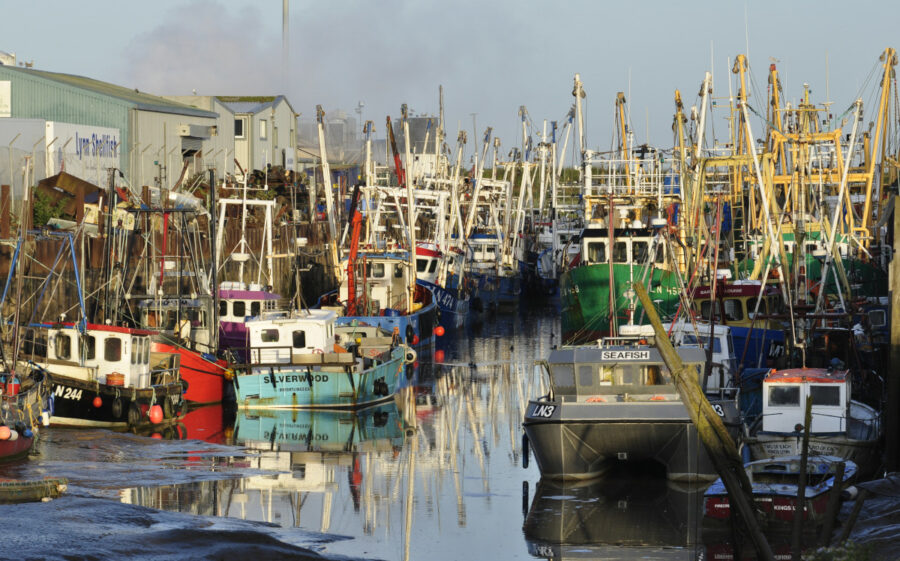As environmental protection exerts the precautionary principle, an age-old fishery is feeling the pinch. John Worrall reports
They’ve been shrimping in the Wash since Pontius was a pilot.
Long beaches, tidal churn, and four sizeable rivers adding flavoursome effluent (less so now – effluent, that is, not flavour) have given that shallow embayment a dynamic benthos upon which its food chain is built. Shrimps, pink and brown, were always part of that, as scavenger, predator and prey.

They’ve been shrimping from King’s Lynn for centuries – if not always with boats like these.
Pinks were once the main commercial catch, and were still featuring a couple of decades ago, but their market faded, and these days, the fishery is about the brown shrimp Crangon crangon.
C. crangon is found from Scandinavia to Morocco, but is of most commercial importance in the southern North Sea where, in 2017, about 30,000t were caught by German, Danish and Dutch boats, amounting to 90% of the total North Sea catch. The Wash fishery accounted for a good part of the rest, including most of what was caught in the UK.
Adult brown shrimps typically grow to a length of 50mm and reach maturity within their first year; not many live into their third. They are found mostly in shallow water on sandy ground – hence the Wash – and are more active at night, otherwise burying themselves in the sand by rapid waggling of their five pairs of legs (which takes 8-10 seconds, in case you’re wondering), with only eyes and antennae protruding, to avoid predators and to ambush prey.
They eat just about any animal material going, and are, in turn, eaten by just about anything bigger that can get hold of them, from fish to birds to us.
In the Wash, they turn up in different places each year, although mostly in the centre and eastern half. From November to March, they tend to move further offshore to avoid the lower salinity brought by winter run-off, and autumn provides the fishery’s traditional peak. But because they are to be found to some extent throughout the year, they have historically formed a fall-back fishery when the two other Wash mainstays – cockles and mussels – are out of season.
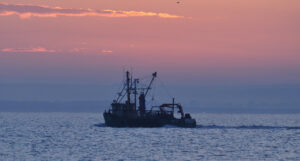
Beaming has been the Wash shrimping method for generations.
But a creeping and fundamental change has come about since the turn of the 21st century, and it comes down to the EC Habitats Directive and the designation, during its first decade, of European Marine Sites (EMSs). These include the Wash and the North Norfolk Coast special area of conservation (SAC), which covers 107,718 hectares – roughly 416 square miles.
Paragraph 6 (2) of the Habitats Directive says: “Member states shall take appropriate steps to avoid, in the special areas of conservation, the deterioration of natural habitats and the habitats of species, as well as disturbance of the species for which the areas have been designated, in so far as such disturbance could be significant in relation to the objectives of this directive.”
And the operative word there is ‘could’ – which straightaway creates a problem for shrimp trawls. Their bobbins, designed to ease the net over the ground and stir shrimps out of their daytime sand immersion and into the net, ‘could’ cause disturbance to other creatures living there. After all, disturb is what bobbins are supposed to do.
It took a while for the full effect of these designations to come to bear, because initially, there was some slack in the regulatory system, and in the UK, fishing was one of the later activities to be brought into line.
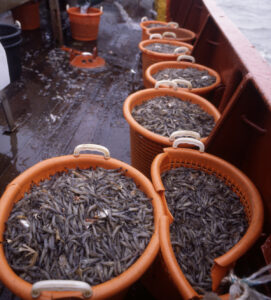
Brown shrimp awaiting onboard cooking.
But in August 2012, the UK government announced its revised approach to the management of commercial fisheries in EMSs, with a view to having initial measures in place by the end of 2013.
Enforcement concentrated first on features considered to be at the highest – ‘red’ – risk, prominent among which were reefs built by Sabellaria spinulosa – Ross worm. These reefs, formed of blocks of tubes 2-3mm in diameter and made of seabed detritus cemented with mucous, are low-rise – mostly up to 50cm – and also ephemeral, because they accrete and decay. But for the years that a reef can exist, it provides protection from predators and swirling currents for lower-order organisms, and the greater the degree of ‘reefiness’ – density – the more protection it provides.
The first round of restrictions for mobile gear introduced by Eastern IFCA came through a flexible byelaw to allow closure of areas considered in need of protection. A handful of relatively small grounds were taken out of the fishery.
But attention has since moved to features considered to be at lesser – ‘amber’ – risk, and critically for the Wash fishery, these include sub-littoral mixed sediments and their benthic communities of worms, early stages of fish species and other lower-order stuff, along with C. crangon, which feeds upon many of them, and is in turn fed upon.
And although shrimping has been going on for a long time, and the natural turbulence of the Wash has been rearranging the seabed for much longer, the now-perceived needs of the SAC bring the precautionary principle into play: if an activity ‘could’ be damaging features or disturbing habitats, it has to be controlled or even stopped.
Over in the Netherlands, seeing all that coming, and with shrimp ground closures already happening, developers of gear technology tried to react.
A Dutch company came up with a new design of trawl called SeeWing, which was claimed to have up to 80% less seabed impact, through the replacement of the traditional round steel beam by an inverted aerofoil design with its weight carried on wheels, rather than sledges, at the ends. It had been developed originally for fish beamers, to reduce drag and thus fuel consumption, which it did by up to 30%. But flatfish catches weren’t good enough, and with Article 6 of the Habitats Directive coming to bear, the emphasis shifted to minimising the ground impact of the big Dutch shrimper fleet.
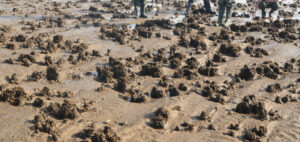
Ross worm Sabellaria spinulosa was one feature that brought about the first round of ground closures. It’s mostly sub-littoral, but one or two patches can be seen at the bottom of a big tide.
So that seemed like something which ought to be looked at in the Wash. In 2016, the two main fishing and processing companies, Lynn Shellfish and John Lake Shellfish, bought a set of SeeWing gear and worked it on one boat, to see if it would help the cause. And it did indeed reduce fuel consumption, by about 15%. But simply working it provided no evidence to refute the ‘could’, and it anyway struggled on soft ground, where the wheels tended to dig in.
Nevertheless, in 2016/17, Eastern IFCA tried to quantify its environmental benefit through trials to compare its seafloor impacts with that of traditional shrimp gear. The trials were initially designed to involve parallel tows of 1,850m, 40m wide, with 75m buffer zones between them, along with control zones for comparison.
But no single patch of mixed sediments of anywhere near that scale could be found, because it turns out that the seabed is a mosaic of different types, of which mixed sediments is one, and the various types merge into each other.
In any case, then came scientific advice to the effect that control zones needed to be left untouched for five years to erase all other influences, because the Wash had long been fished and was already an impacted site. That would have meant excluding all other fishing activity for at least that long. And all of that was in addition to the difficulty of actually observing effects in those murky waters, and doing so within funding window time limits. Eventually, the whole project ran into the sand.
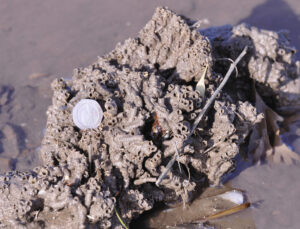
Small and delicate, the clumps of tubes in Ross worm reefs provide cover from tide and predators for lower-order organisms.
But regulatory requirements continued to tighten. In February 2018, Eastern IFCA completed a habitats regulation assessment of the shrimp fishery, as part of a national assessment programme to ensure fisheries were managed in accordance with the 2017 incarnation of the UK habitats regulations.
The good news to come out of that was that habitats in the SAC appeared to be in good condition, despite shrimp fishing. The bad – or unavoidable – news was that it could nevertheless not be proved that shrimping was having no adverse effect. The ‘could’ factor was still there, which meant that some form of restriction was called for, with the proviso, at least, that it should be proportionate – as long as conservation needs were met, at least in terms of preventing habitat degradation, the authority should minimise restriction on the fishery.
That restriction is now forming up in two parts: more ground closures under the flexible byelaw, and a permit scheme to control effort. The point of the latter is to keep effort from going above the level of the past decade, as far as that can be evidenced.
These proposed closures are much more extensive than those in the earlier round, amounting to around 45% of the SAC, although the larger part is along the North Norfolk coast and doesn’t particularly concern shrimpers, who work mainly within the Wash. But in the Wash itself, closures amount to 5,121 hectares, about 11% of the total area, with two-thirds of that in one elongated section running NNE to SSW in the central northern part.
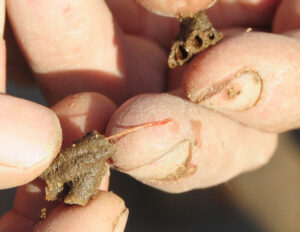
Ross worms are fed upon by pink shrimps, which are no longer a significant part of the Wash fishery.
That latter point could be particularly problematic, given the shrimp’s propensity for congregating in different places each year – it’s a wild animal, after all – because that area is big enough to hold a good part of an average year’s catching options. Add in the 11% overall reduction in Wash open ground, and catches – and margins – will inevitably be squeezed. There is the option of fishing beyond the SAC, but even if there are shrimps to be found out there, a few hours’ extra steaming per trip would be a squeeze in itself – with, dare it be said, more environmental impact.
The closures would take effect after the completion of a consultation process (the deadline for submissions to an informal stage was moved back from 11 October to 4 November) and the ministerial signing-off of the provisions, which means possibly late 2020.
On the permit proposal, meanwhile, consultations have revealed a preference, on balance, for a system without a track record criterion (which is seen as a possible bar to new entrants and to diversification), and for one that works on total allowable effort (TAE), probably to be calculated on a three-year rolling average, in an attempt to ensure that effort doesn’t increase.
If effort was seen to be increasing, boats would be restricted initially to six trips per fortnight – a frequency which, it is said, would have allowed most shrimping activity during 2017 and 2018 – and to fewer trips if the TAE continued to be eroded more quickly. In extreme situations, the fishery could be closed until the start of the next permit year, which would begin on 1 August. That would hurt the two processing plants as well as the boats, because they process shrimps all year.
Detail of shrimp effort in past years is sketchy, although it has fluctuated considerably; it was very low during 2015, when a big cockle fishery occupied most boats. But there would now be stricter enforcement of the existing requirement to complete catch returns, with a prohibition on further fishing if a boat’s returns were more than a month in arrears.
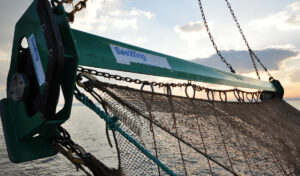
It was hoped that the SeeWing trawl could be shown to be lighter on the mixed sediments, but it didn’t fly.
Alongside all this is Marine Stewardship Council accreditation which, it has been apparent for some time, will be essential if Wash shrimps are to continue to be sold into Europe, as most of them are at present.
The North Sea brown shrimp fishery – that of Germany, Denmark and the Netherlands – has already achieved accreditation, in December 2017, and the Wash brown shrimp fishery, promoted by the Shrimp Producers’ Organisation Ltd (SPO), a joint venture between the two King’s Lynn processors, has been undergoing assessment for nearly two years. It too is about to be accredited.
This hinges on the Brown Shrimp Management Plan, formulated by the SPO, which has its own code of best practice which, although non-statutory, requires all supplier vessels to be signed up. And because accreditation runs for five years and carries conditions for renewal, it means that between them, the SPO and Eastern IFCA will have the fishery as monitored and regulated as it can be, while continuing to function.
Nevertheless, right now the industry is having to go with a statutory nudge factor, without any clear indication of where it will end up.
On the one hand, the regulatory view seems to be that if fishing behaviours do not change significantly, the impacts of the new restrictions should be minimal. The 2018 assessment found that habitats within the SAC appeared to be in good condition, which suggests that their benthic communities have not been obliterated by the occasional passing of shrimp bobbins for generations. If left untouched henceforth, they would probably enrich further, but the same could be said of a farmer’s field, and unless commercial fishing is to be stopped completely, a compromise position is needed.
But on the other, the swirling waters of the Wash are anything but clear, particularly in terms of what goes on at the bottom. Walking the exposed banks at low tide is one thing; knowing as much about the sub-littoral is another thing altogether.
And while legislation – the Habitats Directive in particular – wields a ‘could’ factor that is difficult to prove either way, there is the possibility of further regulatory ratcheting. The direction of travel is certainly to continue to reduce impact – there is talk of bringing beam lengths to a lower average, and of reducing towing speeds – and there will anyway now be a statutory need for gear to be certified as compliant with best practice, with each set of replacement gear needing fresh certification. Eastern IFCA is also planning to set up a register to evidence time-served fishers’ experience of shrimping within the SAC.
However, all of this might just be transitional discomfort for the industry, as it adapts to new statutory regulations at the same time as it voluntarily adopts the substantially parallel best practice required by the MSC. Those ground closures will certainly hurt, and how much remains to be seen. But if the permit system enables regulators to keep closer tabs on effort while they continue to monitor habitat impact – in as far as impact can be monitored – they should be able to keep measures proportionate, and the nudging should indeed finish up at a workable median line.
But then again, if the Marine Stewardship Council is happy, this age-old fishery can’t be doing much wrong.

